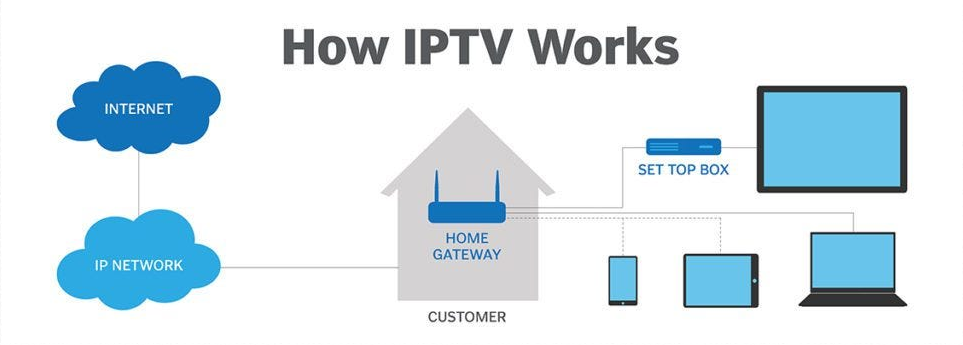The world of digital television is rapidly evolving, and IPTV (Internet Protocol Television) is at the forefront of this change. IPTV allows for the delivery of TV content over internet protocol networks, giving users access to a wide range of channels and services beyond traditional broadcasting. At the heart of any successful IPTV service is the middleware – the software platform that acts as a bridge between the service provider's systems and the end-user's devices. Choosing the right IPTV middleware is crucial for ensuring a smooth, high-quality viewing experience. This guide will walk you through the process of selecting IPTV middleware, offering tips and insights to help you make the best decision.
What is IPTV Middleware?
IPTV Middleware is the backbone of any IPTV service. It is a software platform that manages and delivers content from the service provider to the end-user's device, whether it's a set-top box, smart TV, or mobile device. Middleware is responsible for various tasks, including channel management, video-on-demand (VOD) services, electronic program guides (EPG), and user authentication. In short, it ensures that viewers can access and enjoy their favorite content seamlessly.
How IPTV Middleware Works?
IPTV works by converting traditional TV signals into IP packets, which are then transmitted over the internet to the user's device. The IPTV system consists of three main components: the content provider, the middleware, and the end-user devices. The content provider acquires, stores, and delivers TV content to the middleware, which then manages the content delivery and provides various services to the end-users. The middleware handles requests from the user, communicates with the content delivery network (CDN), and delivers the content in a format compatible with the user's device.
The Role of Middleware in IPTV
Middleware in IPTV is essential for the smooth operation of the service. It sits between the IPTV service provider's CDN and the end-user's device, ensuring that requests for specific TV channels or VOD content are efficiently processed and delivered. Middleware also allows service providers to customize the user interface, manage content, and support multiple devices, thereby enhancing the overall user experience.
Benefits of IPTV Middleware
IPTV Middleware offers numerous benefits for both service providers and end-users. Here are some of the key advantages:
Enhanced User Experience: Middleware allows service providers to customize the user interface, making it more intuitive and user-friendly. This customization can include personalized menus, color schemes, and features that cater to the needs of the viewers.
Streamlined Content Delivery: IPTV Middleware simplifies content delivery, ensuring a smooth and uninterrupted viewing experience. This is particularly important for live TV broadcasts and VOD services, where any disruption can lead to customer dissatisfaction.
Improved Service Management: Middleware provides tools for managing and monitoring the IPTV service, including subscriber management, billing, and content management. This helps service providers ensure that their operations run smoothly and efficiently.
Support for Multiple Devices: With Middleware, IPTV services can be accessed on a variety of devices, including TVs, computers, tablets, and smartphones. This ensures that users can watch their favorite content wherever and whenever they want.
Types of IPTV Middleware
There are several types of IPTV Middleware, each offering different features and functionalities. Understanding these types will help you choose the best solution for your needs.
Electronic Program Guide (EPG): The EPG provides a TV guide with program listings, allowing users to schedule recordings and set reminders. Middleware with a robust EPG is essential for delivering a comprehensive TV experience.
User Authentication and Management: This type of Middleware manages user accounts and authentication, enforcing access control and content restrictions. It's crucial for ensuring that only authorized users can access premium content.
Content Management: Content management middleware organizes and categorizes content libraries, including VOD content. It helps service providers manage large amounts of content and deliver it to users efficiently.
Billing and Subscription Management: This type of Middleware handles subscription plans, billing information, and supports promotional offers. It's vital for monetizing IPTV services and managing customer accounts.
Conditional Access System (CAS): CAS ensures secure content delivery by encrypting and decrypting content, preventing unauthorized access to premium channels. It's a critical component for protecting content from piracy.
Middleware APIs: Middleware with APIs allows for third-party application integration, enabling the development of custom IPTV apps. This is particularly useful for service providers looking to offer unique features and services.
Content Delivery and Streaming: This type of Middleware optimizes content delivery using CDNs and supports adaptive streaming for different devices and bandwidths. It's essential for delivering high-quality video content across various networks.
Interactive TV Services: Middleware with interactive features like voting, quizzes, and polls enhances audience participation during live events. This type of Middleware is ideal for service providers looking to engage their audience in new ways.
Multi-Screen and Cross-Device Compatibility: Middleware that supports multi-screen and cross-device compatibility ensures that users can access IPTV services on various devices and sync their preferences across platforms.
Middleware Security: Security-focused Middleware protects against piracy and content theft by implementing security protocols and monitoring for potential threats. It's crucial for maintaining the integrity of the IPTV service.
Key Features of IPTV Middleware
When choosing IPTV Middleware, it's important to consider the key features that will enhance your service and meet your business needs. Below are some essential features to look for, including the specific offerings from Vodlix:
User Interface Customization: The ability to customize the user interface is one of the most significant benefits of IPTV Middleware. Service providers can design a personalized UI that reflects their branding and meets the needs of their viewers. This includes customizing menus, color schemes, and fonts, as well as adding or removing features.
Video on Demand (VOD): VOD is a popular feature of IPTV services that allows viewers to select and watch content on-demand. With IPTV Middleware, service providers can offer a vast selection of movies, TV shows, and other content organized by genre, rating, or popularity.
Electronic Program Guide (EPG): Vodlix offers an advanced EPG (Electronic Program Guide), which provides a detailed schedule of upcoming programming. It allows viewers to see what's currently airing and what’s coming up next. This feature enhances user experience by enabling easy navigation through channels and programs.
DVR (Digital Video Recorder): The DVR feature allows users to record live TV and watch it later at their convenience. With Vodlix's DVR capability, users can easily record, store, and manage their favorite shows or movies, ensuring they never miss any content.
Catchup TV: Vodlix also offers Catchup TV functionality through a Catchup URL, allowing users to watch previously aired programs. This feature is ideal for viewers who may have missed a show or want to rewatch a program, giving them more flexibility and control over their viewing experience.
Digital Rights Management (DRM): To protect premium content from piracy and unauthorized access, Vodlix includes robust DRM (Digital Rights Management) solutions. DRM ensures that content is securely encrypted and can only be accessed by authorized users, safeguarding the intellectual property of content providers.
Time-Shifting Capabilities: Time-shifting allows viewers to pause, rewind, or fast-forward live TV. This feature is particularly useful for viewers who live in different time zones or have conflicting schedules.
Multi-Screen Support: With IPTV Middleware, viewers can access their favorite content on a range of devices, ensuring a consistent experience across all platforms.
Content Management: IPTV Middleware provides powerful content management tools that allow service providers to manage and deliver content more efficiently. This includes tools for content scheduling, metadata management, and asset management.
Implementation of IPTV Middleware
Implementing IPTV Middleware requires careful planning and execution. Here are the steps to ensure a successful deployment:
Define Your Requirements: Clearly define your business requirements and expectations from the Middleware platform. This will help you choose the right provider and ensure a smooth implementation.
For example If you are a sports broadcaster, you might need Middleware that supports live sports streaming, provides real-time statistics, and integrates with a ticketing system for pay-per-view events.
Prepare Your System: Ensure that your system is ready to integrate the Middleware platform. This includes making sure that your hardware and software are compatible with the Middleware.
For instance, if the Middleware requires a minimum of 16 GB RAM and a multi-core processor, verify that your hardware meets or exceeds these specifications. The Middleware requires Ubuntu 20.04 and MySQL 8.0, ensuring those versions are installed and configured.
Configure the Middleware: Customize the Middleware platform to meet your specific requirements. This includes configuring the user interface, adding channels, and setting up VOD and EPG.
If you are setting up a new sports channel, configure live feed settings, add sports-related metadata, and ensure that schedules for live games and matches are correctly displayed in the EPG.
Integrate the Middleware: Integrate the Middleware with your existing system. This may involve setting up APIs or using other integration methods.
For example, if Middleware offers REST APIs, you would set up endpoints to handle subscription management and payment processing. Configure SSO to allow users to log in with their existing Google or Facebook accounts.
Test the System: Thoroughly test the Middleware platform to ensure it is functioning correctly and meeting your requirements. Run stress tests to simulate thousands of concurrent viewers during a major live event to ensure the platform can handle high traffic and prevent crashes or slowdowns.
Best Practices for a Successful Implementation
✅Clearly Define Business Requirements: Ensure that your hardware and software are compatible with the Middleware platform.
✅Test Thoroughly Before Going Live: Testing helps identify any issues before the system is deployed to users.
✅Train Your Staff: Ensure that your staff is trained on how to use the platform effectively.
✅Set Up Monitoring Systems: Monitor the performance and usage of the Middleware platform to identify any potential issues.
Troubleshooting Common Issues
Check System Logs: Look for any errors or issues in the system logs. If users are experiencing login issues, check the authentication logs for errors related to user credentials or failed login attempts.
Ensure All Components Are Functioning: Verify that all components of the system are working correctly. If your VOD library isn’t updating, check that the VOD server and database are online and that there are no issues with the content ingestion process.
Verify Middleware Configuration: Ensure that the Middleware is properly configured. If the EPG data isn’t displaying correctly, review the configuration settings to ensure that the EPG source is correctly integrated and that the schedule data is accurately mapped.
Seek Technical Support: Contact the Middleware provider for support if necessary. If you’re experiencing an issue with integration APIs, reach out to the Middleware provider’s support team with specific details about the API calls and errors received.
How to Choose the Right IPTV Middleware Provider?
When selecting an IPTV Middleware provider, consider the following factors:
Cost: Opt for a provider that offers competitive pricing without compromising on the quality of service. Compare pricing tiers and features to ensure you get the best value for your investment. Look for transparent pricing models and avoid hidden costs.
Example: A provider with a tiered pricing structure allows you to start with a basic plan and scale up as needed, ensuring you only pay for the features you use.
User Interface Customization: Choose a provider that offers extensive customization options to create a branded IPTV platform. This should include the ability to modify the user interface to match your company’s branding and design preferences.
Example: Look for providers that offer customizable themes, logos, and layout options so you can tailor the look and feel of your IPTV platform to align with your brand identity.
Features: Ensure that the provider includes all the essential features you need, such as video-on-demand (VOD), electronic program guides (EPG), time-shifting, multi-screen support, and robust content management tools.
Example: Select a provider that supports VOD libraries, live TV streaming, time-shifted viewing, and multi-device access to meet your diverse content delivery needs.
Scalability: Choose a provider that offers scalable solutions to accommodate your business growth. The provider should be able to handle increased user demand and additional features as your service expands.
Example: Opt for a provider with cloud-based infrastructure that can easily scale up resources to support a growing user base and increased content offerings.
Technical Support: Ensure that the provider offers reliable technical support and assistance. Look for providers with a strong reputation for customer service and offer multiple support channels, such as live chat, email, and phone.
Example: Select a provider that offers 24/7 support and a dedicated account manager to assist with any technical issues or questions that arise.
Questions to Ask Potential Providers
What is your experience in the industry, and how long have you been providing Middleware services?
What features do you offer, and can you customize the platform to meet our specific needs?
How do you ensure the security and reliability of your service?
What level of technical support do you provide, and how quickly can we expect a response in case of any issues?
Can you provide references or case studies from other businesses that have used your service?
Tips for Evaluating Demo Versions
⭐Test All Features: Ensure that all features meet your needs.
⭐Check Performance: Ensure the Middleware performs well and provides a smooth user experience.
⭐Consider Ease of Use: Ensure the Middleware is easy to use and customize.
⭐Seek Feedback: Ask your team for feedback on the Middleware.
Conclusion
Choosing the right IPTV Middleware is crucial for delivering a high-quality IPTV service. By understanding the different types of Middleware, evaluating potential providers, and implementing best practices, you can ensure that your IPTV service is reliable, scalable, and meets the needs of your viewers.

.jpg)


.png)


